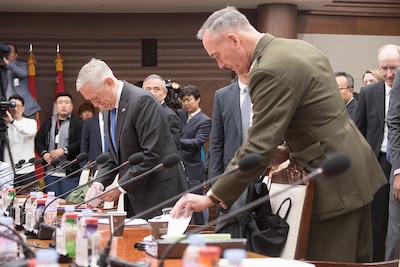By Jim Garamone DoD News, Defense Media Activity
ABOARD A U.S. MILITARY AIRCRAFT, Oct. 28, 2017 — U.S. and
South Korean defense chiefs discussed the full range of issues confronting the
alliance during two days of talks in Seoul, the chairman of the Joint Chiefs of
Staff said today.
Marine Corps Gen. Joe Dunford spoke to reporters after the
Security Consultative Meeting in Seoul. The chairman is traveling to Hawaii for
the Tri-CHOD (chief of defense) conference among the United States, Japan and
South Korea.
During his visit to South Korea, also known as the Republic
of Korea, Dunford met with his South Korean counterpart Air Force Gen. Jeong
Kyeong-doo at the Military Committee Meeting.
American and South Korean military leaders attend the MCM to
chart the way ahead for the alliance, Dunford said. Held each year since 1978,
senior military officials gather to discuss what has occurred over the past year
and to determine the best ways to move ahead.
Defense Secretary Jim Mattis and South Korean Minister of
National Defense Song Young-moo received the report of the MCM and continued
the discussions at the follow on Security Consultative Meeting.
Opportunity for U.S.-South Korea Discussions
The meetings are an annual opportunity for leaders to
discuss issues the U.S.-South Korea alliance faces and assess how well the
issues are being dealt with, Dunford said. The meetings, he added, also provide
both countries the opportunity to plan and look ahead and set milestones.
The U.S. and South Korean military leaders spent a lot of
time discussing the transfer of operational control to the South Korean
military, Dunford said. No date has been set for the transfer yet, he added.
Currently the commander of Combined Forces Command -- the
warfighting command for security on the Korean Peninsula -- is Army Gen.
Vincent K. Brooks. He is also the commander of U.S. Forces Korea and the United
Nations Command. The general’s chain of command goes to both the U.S. White
House and the South Korean president’s Blue House.
South Korea Seeks Increased Security Responsibility
The South Koreans “rightfully seek increased responsibility
for their own security,” Dunford said. “If we are committed to an alliance, we
are going to want to make sure that we’re involved in the decision making
process for the employment of those forces. There’s got to be a framework that
addresses what will surely be U.S. considerations for how is operational
control affected, how decisions are made and so forth.”
The leaders affirmed a couple of things about operational
control, Dunford said. First, he said, there are certain conditions that must
be met before the shift can occur.
“We’ve got a very detailed list of what has to be done,” the
chairman said. “We will meet those conditions and do it in a way that maintains
or improves our overall effectiveness.”
Whatever happens, though, must maintain the bilateral method
for making decisions, he said.
“The key thing in any alliance is the transparency that
leads to trust,” Dunford said. “Secretary Mattis was quoted the other day
saying there are three things that are important in the alliance and they are
‘trust, trust and trust.’”
The bottom line is the alliance must not suffer degradation
in combat capability given the nature of the threat, simply to make a change,
the chairman said.
“We did talk about ROK capability development, which is
associated with OPCON transition -- command and control systems, ballistic
missile defense, cyber capabilities,” Dunford said.
Multilateral Approach to Address Threats
The leaders spoke about increasing the multilateral approach
to the North Korean threat, the chairman said. One way to increase multilateral
cooperation, he said, is through the United Nations Command, which was
established in 1950 soon after North Korea invaded the south. Regional nations
like Australia, India, Japan and others could potentially participate.
The leaders also talked about enhancing ballistic missile
defense capability, and enhancing the information and intelligence-sharing
network, Dunford said. They also spoke about improving South Korean
command-and-control systems.
“I think it is fair to say, I know I do, all of us have a
heightened sense of urgency over the past year-and-a-half and in particular
over the past few months,” Dunford said. “We’ve got to make sure that as [South
Korea] increases their ballistic missile
defense capability, we all have a common picture of the threat so we can
integrate our capability to respond. And that applies to BMD, it applies to
strike capability, it applies to targeting. If we are going to fight as an
alliance we’ve got to be completely interoperable and interoperable in peace time
and be able to integrate in combat.”









